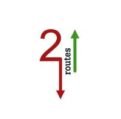There are two main interpretations of “trend” in trading: + consolidation (Up / Down and Sideway)
1. The overall market direction:
- This refers to the prevailing price movement in a specific market or asset class.
- It can be upward (uptrend), downward (downtrend), or sideways (consolidation).
- Identifying trends is a crucial aspect of technical analysis, used to make informed trading decisions.
2. Trend trading as a strategy:
- This is a trading style that capitalizes on the momentum of established trends.
- Trend traders aim to buy assets in uptrends and sell assets in downtrends.
- They utilize various technical analysis tools like moving averages, trendlines, and momentum indicators to identify trends and potential entry and exit points.
Here’s a breakdown of both:
Market Trends
- Uptrend: A series of higher swing highs and higher swing lows.

- Downtrend: A series of lower swing highs and lower swing lows.

- Consolidation: The price fluctuates within a specific range without a clear upward or downward direction.

Understanding the current trend allows traders to:
- Align their trades with the prevailing market sentiment. Buying during uptrends and selling during downtrends increases the probability of profitable trades.
- Identify potential support and resistance levels. Support refers to price levels where the downtrend might pause or reverse, while resistance refers to price levels where the uptrend might pause or reverse.
Trend Trading Strategy
- Trend traders look for:
- Confirmation of a trend: This could involve using moving averages or trendlines to validate the trend’s direction.
- Entry points: These are points where the price action aligns with the trend’s direction, offering an opportunity to enter a trade.
- Risk management: Stop-loss orders are crucial to limit potential losses if the trend reverses unexpectedly.
- Exit points: This involves taking profits when the trend weakens or shows signs of reversal.
Remember:
- Trend trading is not foolproof. Markets can be volatile, and trends can reverse quickly.
- It’s important to use trend analysis alongside other trading strategies and risk management techniques.
